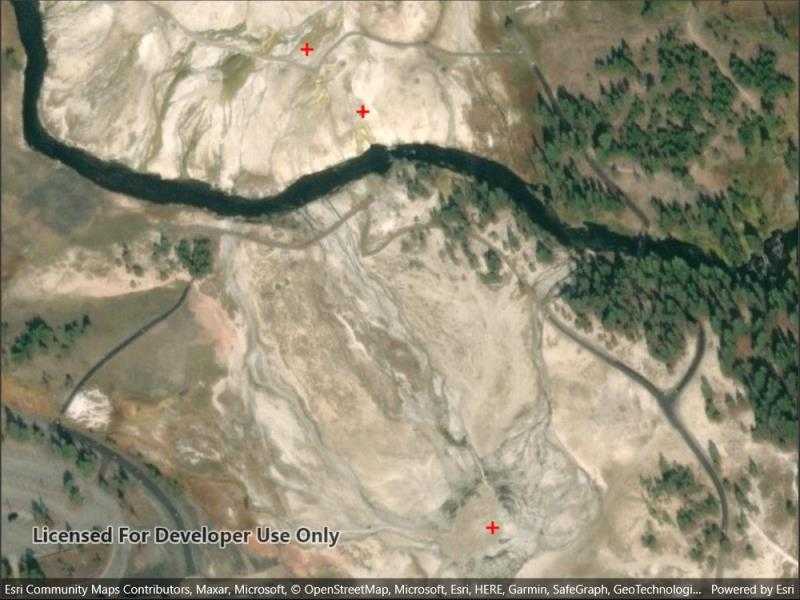Display common symbols for all graphics in a graphics overlay with a renderer.

Use case
Graphics are often used to display data that changes location regularly because they are held in memory instead of being persisted to the map. When a number of graphics are required to share the same style, a simple renderer can be applied to the graphics overlay containing the graphics. For example, the location of mobile taxis from a same company could be plotted on a map with each taxi marked by a relevant symbol.
How to use the sample
The sample loads with a predefined simple renderer, which displays a red cross simple marker symbol for the graphics in the graphics overlay.
How it works
- Create a
GraphicsOverlay. - Create a number of
Pointobjects with x, y and spatial reference parameters. - Create a
SimpleMarkerSymbolpassing in aSimpleMarkerSymbol.Style, color and size as parameters. - Create a simple renderer with
SimpleRenderer(simpleMarkerSymbol). - Set the simple renderer to the graphics overlay using
graphicsOverlay.setRenderer(simpleRenderer). - Create a number of
Graphicobjects with the points initiated in step 2. - Add the graphics to the graphics overlay with
graphicsOverlay.Graphics.Add(graphic).
Relevant API
- Graphic
- GraphicsOverlay
- Point
- SimpleMarkerSymbol
- SimpleRenderer
Additional information
Renderers are used to display graphics that don't already have a symbol set. A renderer will not override a graphic's symbol if one has been set.
Tags
graphics, marker, renderer, symbol, symbolize, symbology
Sample Code
// Copyright 2022 Esri.
//
// Licensed under the Apache License, Version 2.0 (the "License"); you may not use this file except in compliance with the License.
// You may obtain a copy of the License at: http://www.apache.org/licenses/LICENSE-2.0
//
// Unless required by applicable law or agreed to in writing, software distributed under the License is distributed on an
// "AS IS" BASIS, WITHOUT WARRANTIES OR CONDITIONS OF ANY KIND, either express or implied. See the License for the specific
// language governing permissions and limitations under the License.
using Esri.ArcGISRuntime.Geometry;
using Esri.ArcGISRuntime.Mapping;
using Esri.ArcGISRuntime.Symbology;
using Esri.ArcGISRuntime.UI;
using Colors = System.Drawing.Color;
namespace ArcGIS.Samples.SimpleRenderers
{
[ArcGIS.Samples.Shared.Attributes.Sample(
name: "Simple renderer",
category: "Symbology",
description: "Display common symbols for all graphics in a graphics overlay with a renderer.",
instructions: "The sample loads with a predefined simple renderer, which displays a red cross simple marker symbol for the graphics in the graphics overlay.",
tags: new[] { "graphics", "marker", "renderer", "symbol", "symbolize", "symbology" })]
public partial class SimpleRenderers : ContentPage
{
public SimpleRenderers()
{
InitializeComponent();
// Create the UI, setup the control references and execute initialization.
Initialize();
}
private void Initialize()
{
// Create new map with basemap layer.
Map myMap = new Map(BasemapStyle.ArcGISImagery);
// Create several map points using the WGS84 coordinates (latitude and longitude).
MapPoint oldFaithfulPoint = new MapPoint(-110.828140, 44.460458, SpatialReferences.Wgs84);
MapPoint cascadeGeyserPoint = new MapPoint(-110.829004, 44.462438, SpatialReferences.Wgs84);
MapPoint plumeGeyserPoint = new MapPoint(-110.829381, 44.462735, SpatialReferences.Wgs84);
// Use the two points farthest apart to create an envelope.
Envelope initialEnvelope = new Envelope(oldFaithfulPoint, plumeGeyserPoint);
// Use the envelope to define the map views visible area (include some padding around the extent).
myMap.InitialViewpoint = new Viewpoint(initialEnvelope);
// Add the map to the map view.
MyMapView.Map = myMap;
// Set the viewpoint to the envelope with padding.
MyMapView.SetViewpointGeometryAsync(initialEnvelope, 50);
// Create a graphics overlay .
GraphicsOverlay myGraphicOverlay = new GraphicsOverlay();
// Create graphics based upon the map points.
Graphic oldFaithfulGraphic = new Graphic(oldFaithfulPoint);
Graphic cascadeGeyserGraphic = new Graphic(cascadeGeyserPoint);
Graphic plumeGeyserGraphic = new Graphic(plumeGeyserPoint);
// Add the graphics to the graphics overlay.
myGraphicOverlay.Graphics.Add(oldFaithfulGraphic);
myGraphicOverlay.Graphics.Add(cascadeGeyserGraphic);
myGraphicOverlay.Graphics.Add(plumeGeyserGraphic);
// Create a simple marker symbol - red, cross, size 12.
SimpleMarkerSymbol mySymbol = new SimpleMarkerSymbol(SimpleMarkerSymbolStyle.Cross, Colors.Red, 12);
// Create a simple renderer based on the simple marker symbol.
SimpleRenderer myRenderer = new SimpleRenderer(mySymbol);
// Apply the renderer to the graphics overlay (all graphics use the same symbol).
myGraphicOverlay.Renderer = myRenderer;
// Add the graphics overlay to the map view.
MyMapView.GraphicsOverlays.Add(myGraphicOverlay);
}
}
}